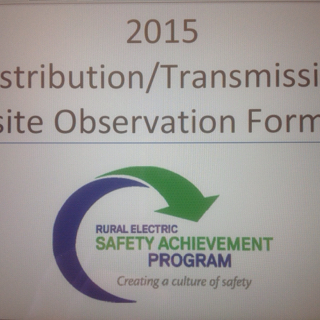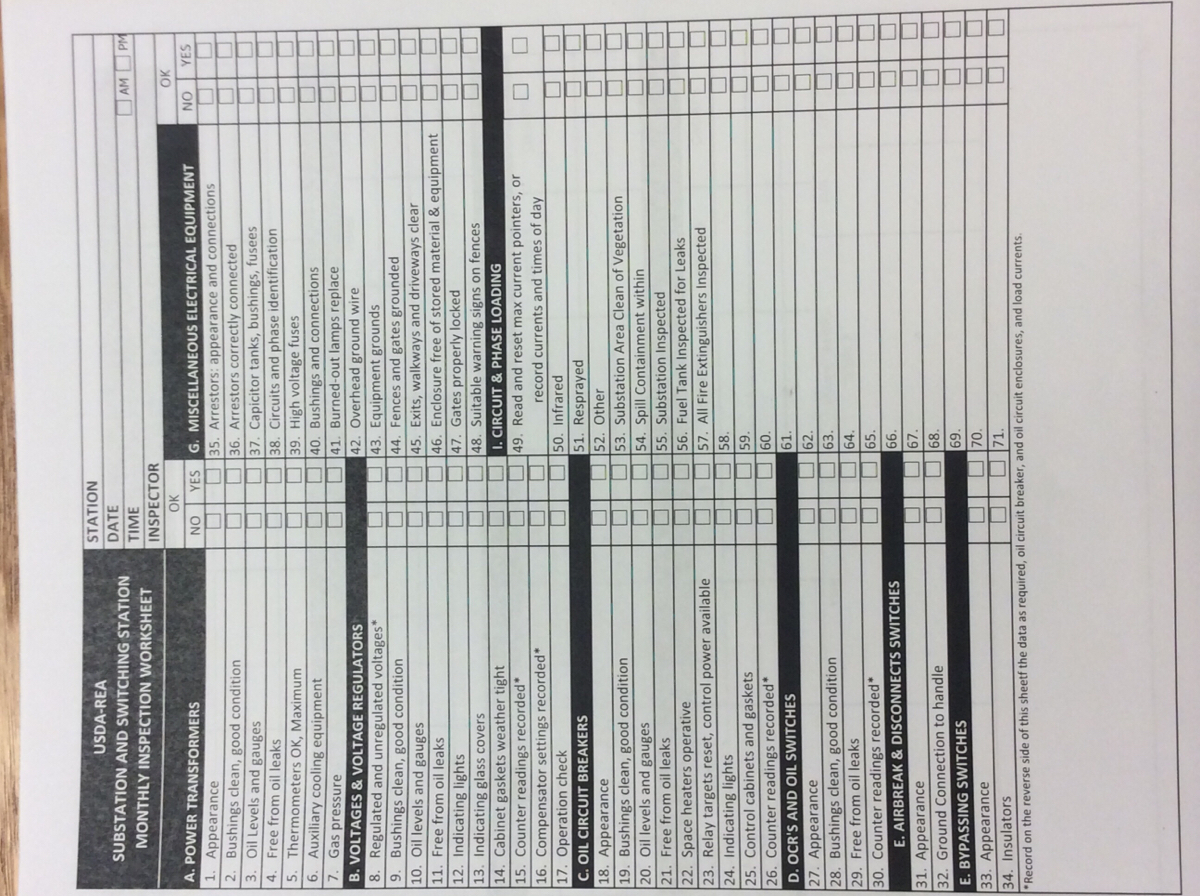Title Page
-
Cooperative Name
-
Location
-
- Main Facility
- Outpost
-
Conducted on
-
Prepared by
Section 14: Maintenance Facilities
-
4.1 Welding areas are properly equipped and maintained.<br>Criteria: <br>* Welding areas are clearly marked "Welding Area".<br>* Welding area is designed with protective shield or curtain to protect workers and other people in the vicinity of this welding activity.<br>* Signs are posted indicating "Eye Protection Required".<br>* Proper power ventilation is provided in welding areas/rooms.<br><br>ref: 29 CFR 1910 Subpart Q
-
4.2 Welding safety equipment, helmets face shields, goggles, gloves, sleeves, and aprons are available, in serviceable condition and meet the applicable OSHA/ANSI standards.<br><br>ref: 29 CFR 1910.252(b)(2); 29 CFR 1910.252(b)(3)
-
4.3 Welding equipment, cables, connections, clamps and electrode holders are in good condition.
-
4.4 All gas cylinders are capped when not in use, stored upright, and secured to avoid tipping.<br>Criteria:<br>* Full and empty cylinders are properly stored in areas marked "Empty" and "Full" accordingly.<br>* Cylinders with substances that react with other substances are stored in separate locations except those cylinders being used and/or those mounted on a welding cart during use. <br><br>ref: 29 CFR 1910.253(b)(2); 29 CFR 1910.253(b)(4)
-
4.5 Tire changing tools and safety equipment are in good condition.<br>Criteria:<br>* Clip-on chucks, in-line valves, and pressure gauges are part of these air-line assemblies.<br>* Length of hose between the clip-on chuck and the in-line valve is sufficient to keep maintenance workers clear of hazards. <br><br>ref: 29 CFR 1910.177/1910.177 App A
-
4.6 Cranes and overhead lifting devices are inspected by the operators before each use and annually documented by a certified inspector. <br>Criteria:<br>* Evidence of annual inspection is readily available upon request.<br>* Interviewed crane equipment users can explain key items inspected before each use. <br><br>ref: 29 CFR 1910.179(j)
-
4.7 Floor hoists, jacks, and jack stands are clearly marked with capacity ratings and are found in good, useable condition.<br><br>ref: 29 CFR 1910.244(a)
-
4.8 Portable battery charges are in good condition and clearly marked with "No Smoking" and "Eye Protection Required" signs.
-
4.9 Electrical power tools and equipment have 3-wire grounding or are double-insulated and maintained in very good condition in all facilities. <br><br>ref: 29 CFR 1910.242; 29 CFR 1910.243; 29 CFR 1910.269(i)
-
4.10 All tools and equipment are in good condition and if not, they are marked "Out of Service".<br><br>ref: 29 CFR 1910.242; 29 CFR 1910.243
-
4.11 All tools are stored in special containers or designated locations.
-
4.12 Shields/guards are in place and well maintained for power tools.<br><br>ref: 29 CFR 1910.242<br><br>
-
4.13 At each power tool station there are clean goggles and face shields are available with signs posted requiring use of these items.<br><br>ref: 29 CFR 1910.133; 29 CFR 1910.145; ANSI Z535
-
4.14 Interviewed employees are able to explain the safe use of these maintenance area tools and equipment.
-
4.15 Flammable cabinets are available for storage of flammable materials, without leaks or spills, and meet regulatory requirements for design and use. <br>Criteria:<br>* Flammable cabinets are labeled or marked with wording, "Flammable" and "No Smoking".<br>* Flammable cabinets are closed and latched after each use.<br>* Each flammable cabinet has a maximum capacity of 60 gallons for class I or class II liquids and maximum 120 gallons of class II liquids. <br>* Containers with a maximum 5 gallon capacity (lower state maximum capacities may apply) are stored inside flammable cabinets.<br>* Flammable cabinets are either vented to the outside or the vent is capped.<br>* Flammable cabinets are located away from facility energized electrical equipment where feasible.<br>* A maximum of 3 flammable cabinets are located in any work area. <br>* Contents are stored in an orderly manner.<br><br>ref: 29 CFR 1910.106(d)(3); NFPA 30
-
4.16 Portable flammable containers are designed and labeled for the product being stored and meet current use and storage requirements.<br>Criteria:<br>* A pressure relief is available and operational.<br>* Containers must be wither Factory Mutual (FM) or Underwriters Laboratory (UL) rated. (Note - FM requires flame arrestor screens in safety cans for approval, but UL does not require them for approval (NFPA recognizes approval of FM or UL rating).<br>* Containers are marked or color coded (red for gasoline, blue for kerosene, yellow for diesel and green for oil) for the liquid being contained. Containers are stored where the product will not create additional hazards. <br>* For incidental storage or use of flammable liquid - the quantity of liquid that may be located outside an inside storage room or storage cabinet in a building should not exceed: 25 gallons of Category 1 flammable liquids (i.e., flashpoint below 73.4 F and a boiling point at or below 95 F) in containers; 120 gallons of Category 2 (i.e., fp <73.4 F and bp> 95 F).<br>* Category 3 (i.e., fp at or above 73.4 F and bp at or below 140 F) or Category 4 (i.e., fp>140 F and bp at or below 199.4 F) flammable liquids.<br><br>ref: 29 CFR 1910.106(d)(2); 1910.106(e)(2); NFPA 30
-
4.17 Flammable storage rooms meet the current use and design requirements.<br>Criteria:<br>* Flammable storage rooms have mechanical ventilation equipment.<br>* Trash receptacles in these rooms are metal containers with self-closing lids.<br>* All flammable materials are stored in an orderly manner and free of any leaks or spills.<br>* Doors are closed and latched after each use.<br>* These rooms are designed to capture and contain flammable materials leaks or spills.<br>* Explosion resistant electrical equipment is being used in flammable material rooms. <br>* Flammable room entrances are marked with "Flammable" and "No Smoking" signs. <br><br>ref: 29 CFR 1910.106(d)(4); NFPA 30
-
4.18 Parts cleaning and other solvents (flammable or biodegradable) are stored and used properly in maintenance/repair facilities. <br>Criteria:<br>* Approved containers for dispensing solvents are available.<br>* Parts washer is well maintained and UL listed.<br>* Proper ventilation is available for solvent use and proper solvent disposal practices are in place.<br>* Appropriate PPE is available for use at each parts washer (rubber gloves, goggles, splash apron).<br>* Eye wash station is within regulatory distance to the parts washer.<br><br>ref: 29 CFR 1910.106<br>
-
4.19 Battery charging areas are properly equipped and maintained.<br>Criteria:<br>* Battery charging and storage operations include charging batteries for powered industrial trucks, uninterrupted power supplies or battery backup systems, battery systems for emergency generators or lighting systems and other similar devices. These systems may include lead acid batteries and other similar devices. <br>* Charging and low-voltage battery systems such as rechargeable NiCad batteries, Lithium-ion batteries, small consumer batteries, self-contained uninterruptible power supplies (typically used for small consumer products), etc. is not included. <br>* Battery charging areas have "No Smoking" and "Eye and Face Protection Required" signage.<br>* Battery charging areas have proper ventilation and racks or trays resistant to electrolyte.<br>* Eye and face protection, chemical gloves, and chemical aprons are provided in battery charging areas.<br>* Batteries systems are inspected/tested per manufacture recommendations.<br><br>ref: 29 CFR 1910.178, 29 CFR 1926.441
-
4.20 "High voltage" electrical repair/test area has wall, fence, or barrier, wiring with ground connections, test status signal, disconnect switch, and separated power cables. <br>Criteria:<br>* All test areas, temporary and permanent include, as a minimum, test area guarding, grounding, and the safe use of measuring and control circuits.<br>* A means should be established to ensure periodic safety checks of field test areas to ensure that safety work practices and conditions are established and used.<br>* Guarding is provided within test areas to control access to test equipment or to apparatus under test. <br>* Safe grounding practices are established including conductive parts accessible to the test operator. <br>* System test status signals, if used, are in operable condition.<br>* Test power disconnects are clearly marked and readily available in an emergency.<br>* Ground connections are clearly identifiable.<br>* Personal protective equipment is provided and used.<br>* Signal, ground, and power cables are properly separated.<br><br>ref: CFR 1910.269(o)
-
4.21 Explosives are properly secured and stored at the facility which is approved and licensed according to current regulations related to the class of explosives and detonators used. <br>Criteria:<br>* Approved containers are used for the class of explosive and detonators.<br>* Unused explosives and detonators are returned to the magazine at the end of the day as required.<br>* Documentation of the amount of explosives and the number of detonators received, used, and on hand must be accurate and up to date.<br>* Interviewed employees, authorized to handle or use explosives, are adequately trained, licensed, and can explain their basic safety procedures for use of these materials. <br>* Cadweld and shoot-on type connectors are not considered explosives under this assessment question.<br><br>ref: CFR 1910.109
Section 4: Summary
-
4.22 The overall evaluation of the onsite field observation team for this section of the assessment is as follows:<br>Criteria: <br>* Strong performance - Questions evaluated as exceeds or satisfies all requirements.<br>* Satisfactory performance - Questions evaluated as satisfies all requirements, could be a small number evaluated as exceeds.<br>* Generally satisfactory with minor areas for improvement - Questions evaluated as satisfies all or most requirements, improvement areas are minor<br>* Key attention areas for improvement - Questions evaluated as partially satisfies or fails to satisfy requirements in important improvement areas<br>
AIEC Safety Personnel Signature
-
Stephen Davis
-
Daren Deverman








